Crypto Guide: The Differences Between Fiat Currency And Cryptocurrencies
Last Update: November 28th, 2024

What is FIAT Currency?
Chances are high that you have heard the term fiat numerous times already, but you might wonder what it has to do with our financial system. In fact, when economists and financial analysts talk about fiat, they certainly are not talking about the Italian automobile manufacturer but about the currencies which are commonly used around the globe. To be more specific, fiat money describes a currency without intrinsic value that has been established as a medium of exchange (money), often by government regulation (central banks).
Fiat currency does not have intrinsic value and has value only because a government maintains its value (by manipulating the supply), or because parties engaging in exchange agree on its value. The fiat currency value is derived from government backing and global investor confidence in the government’s ability to repay debts. In contrast to commodity value such as silver, gold or food, fiat money does not have value by itself (= intrinsic value).
The circulating money used to be backed by gold, which is commonly known as the gold standard. Consequently, formerly currencies could be seen as representative money, which is similar to fiat money, but it represents a claim on a commodity (which can be redeemed to a greater or lesser extent).
However, with the abandonment of the gold standard during World War I, the circulating money wasn’t tied to value anymore, but only to the belief that the money is worth something, although money is, essentially, just a piece of paper.
Central bank digital currencies (CBDCs) are now being explored by governments as a new form of fiat money that combines the benefits of cryptocurrencies with the regulatory oversight of traditional central banks, aiming to enhance financial inclusion, improve cross-border payments, and increase efficiency in monetary policies.
Definition of Fiat Currency
Fiat currency, also known as fiat money, is a type of currency that is issued by a government and is not backed by any physical commodity like gold or silver. Instead, its value comes from the government’s decree or order, making it legal tender for financial transactions.
Essentially, fiat currency has value because the government maintains it and people have faith in its purchasing power. This form of currency is the standard in modern economies and is widely used for international trade and commerce.
Characteristics of Fiat Currency
Fiat currency has several key characteristics that set it apart from other types of currency:
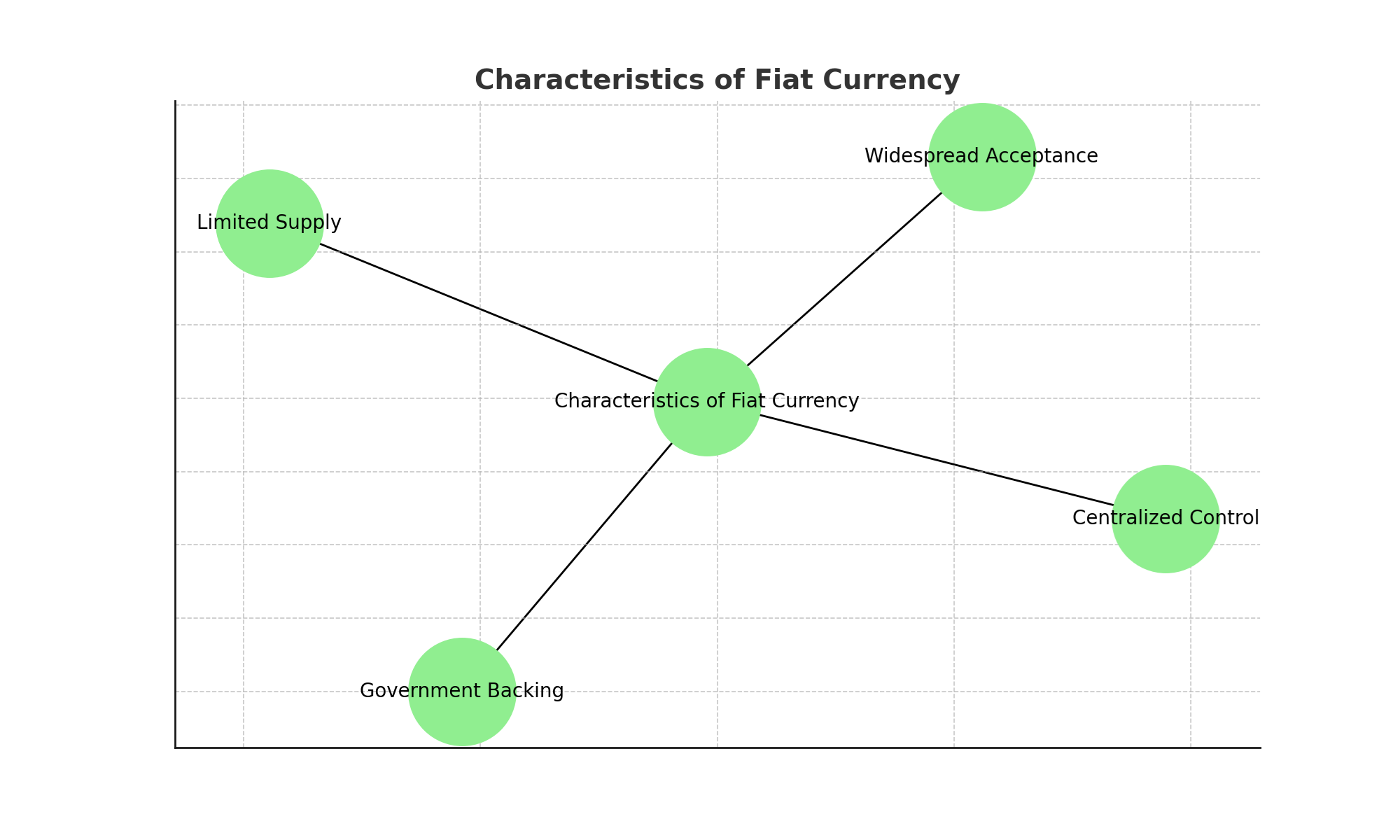
- Centralized Control: Fiat currency is issued and regulated by a central authority, such as a government or central bank. This central authority has the power to control the money supply and implement monetary policies.
- Government Backing: The value of fiat currency is backed by the government that issues it. This government backing guarantees its acceptability as a medium of exchange and helps maintain its value.
- Limited Supply: The supply of fiat currency is controlled by the central bank, which can adjust the money supply to manage inflation and stabilize the economy. This control helps in maintaining economic stability.
- Widespread Acceptance: Fiat currency is widely accepted for financial transactions around the world. Its acceptance is due to the trust and confidence people have in the issuing government and its economy.
These characteristics make fiat currency a reliable and stable medium of exchange in the global financial system.
Examples of Fiat Currencies
Examples of fiat currencies include some of the most widely used and recognized currencies in the world:
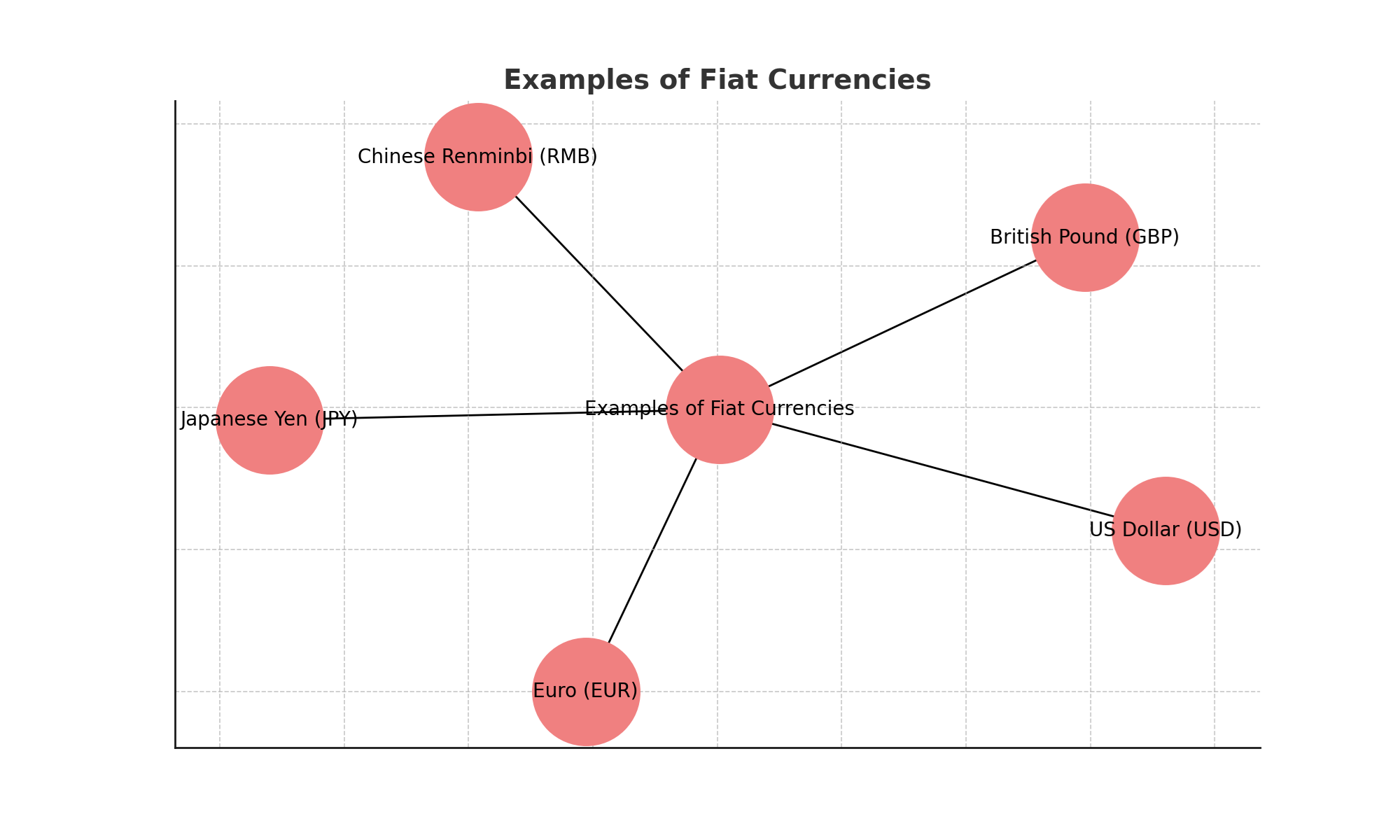
- US Dollar (USD): The primary currency of the United States and a dominant currency in global trade.
- Euro (EUR): The official currency of the Eurozone, used by 19 of the 27 European Union countries.
- Japanese Yen (JPY): The official currency of Japan, known for its stability and significant role in international finance.
- British Pound (GBP): The official currency of the United Kingdom, one of the oldest currencies still in use.
- Chinese Renminbi (RMB): The official currency of China, increasingly important in global trade and finance.
These fiat currencies are integral to the global financial system and are used for a vast majority of financial transactions worldwide.
i. Intrinsic Value
And that’s exactly what fiat currencies are – a means of exchange without intrinsic value which is valuable because of the widespread acceptance of such currencies. When people stop accepting dollar, your dollar savings decrease in value because there is no intrinsic value. When currencies become worthless, you might only use it as fuel for your fireplace.
In the context of fiat vs crypto, cryptocurrencies, on the other hand, derive their value from scarcity and the technology behind them, offering a different perspective on intrinsic value.
ii. Money Supply
The money supply refers to the total amount of money in circulation within an economy, managed and regulated by central banks to maintain economic stability. This control directly impacts inflation and deflation, affecting the purchasing power of the currency.
Key Points on Money Supply
- Central Bank Control:
- Central banks, like the European Central Bank (ECB) and the US Federal Reserve, regulate the money supply.
- They implement monetary policies to maintain price stability and support employment.
- Inflation and Deflation:
- Inflation: Occurs when money supply increases, reducing the value of currency and decreasing purchasing power.
- Deflation: Happens when money supply contracts, strengthening purchasing power but potentially slowing economic activity.
- Inflation Targets:
- The ECB and Federal Reserve aim for an annual inflation rate of 2% to balance economic growth and stability.
- A small, steady inflation rate minimizes risks of harmful deflation, which can lead to falling wages and weak economic conditions.
- Impact of Inflation:
- A higher inflation rate erodes the public’s ability to plan long-term financial decisions.
- A lower inflation rate may increase the risk of deflation, destabilizing the economy.
- Economic Growth:
- Europe’s annual economic growth is around 2%, while the US sees approximately 3% growth.
- Moderate inflation supports this growth by encouraging spending and investment.
- Regulatory Challenges:
- Variations in regulations across countries can impact the central bank’s ability to control inflation and deflation.
- Regulatory uncertainty creates challenges in maintaining consistent economic policies.
Moreover, the annual economic growth is around two percent in Europe and close to three percent in America, which makes small inflation reasonable.

iii. Banking System and Central Banks
The financial system heavily relies on a structured hierarchy led by central banks, followed by private banks, which manage the flow of money and credit to governments, businesses, and individuals.
Key Aspects of the Banking System
- Structure and Hierarchy:
- Central banks, such as the Federal Reserve and the European Central Bank, issue currency and oversee monetary policy.
- Smaller private banks distribute this money to households and businesses through loans and financial services.
- Loan-Based Economy:
- The financial system is fundamentally built on credit.
- Central banks lend money to governments and private banks, which in turn extend credit to individuals and companies.
- Global debt reached approximately $233 trillion in 2018, reflecting the deep integration of loans into the economic system.
- Interest Rates and Profitability:
- Banks earn through interest on loans and various service fees.
- Central banks adjust interest rates to influence borrowing costs and manage economic activity.
- Over time, compound interest and global indebtedness contribute to a widening gap in wealth distribution.
- Impact on Wealth Distribution:
- The accumulation of capital by banks through interest and fees often exacerbates economic inequality.
- High levels of debt can lead to financial crises, impacting individuals and businesses disproportionately.
- Potential for Change:
- A financial system without traditional banks could reduce dependency on loans.
- This shift might empower individuals and businesses, potentially leading to a more equitable distribution of wealth.
By understanding the role and influence of central banks and the broader banking system, one can better evaluate its impact on economic stability and wealth distribution.
iv. Risk Factors
Traditional financial systems are inherently tied to loans, which are deeply embedded in modern economies. This integration means that the costs of loans are factored into nearly every transaction, allowing banks to profit significantly.
Ultimately, customers bear these costs, contributing to economic inequality. In contrast, alternative systems without traditional banking could potentially redistribute wealth more equitably.
Financial crises often exacerbate these risks, disproportionately affecting individuals with debt. Historical examples, from the 1920s to the 2008 crisis, illustrate how hyperinflation and rising interest rates can force individuals into insolvency.
Banks then acquire the properties of those unable to repay their loans, further concentrating wealth within financial institutions. For perspective, the average US citizen is burdened with debt amounting to $67,494, underscoring the widespread nature of this issue.
Adding to these challenges, modern banking systems operate largely on “scriptural money”—digital credits rather than physical reserves. Reserve ratios, which dictate the portion of deposits a bank must physically hold, are often alarmingly low. For instance:
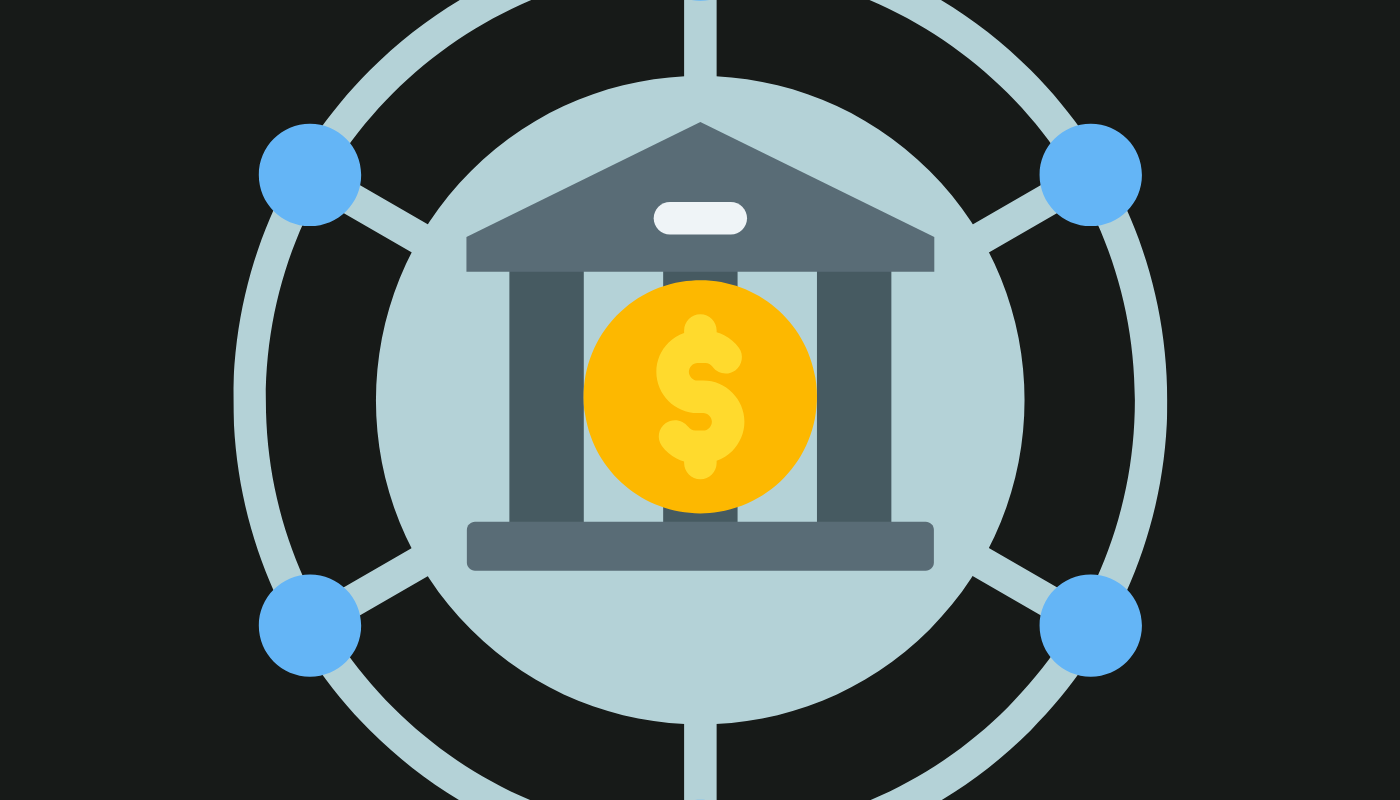
- China: 13.5% reserve ratio.
- Federal Reserve (US): 10% reserve ratio.
- European Central Bank: 1% reserve ratio.
These figures mean that banks cannot accommodate mass withdrawals, as most deposits are not backed by tangible assets. With the gold standard no longer in place, account balances today rely solely on trust in the financial system, posing a significant risk of capital loss during crises.
Key Risk Factors
- Economic Inequality:
- Loan costs are embedded in every transaction, disproportionately benefiting banks at the expense of customers.
- Repeated financial crises magnify wealth concentration by shifting assets from individuals to banks.
- Systemic Vulnerabilities:
- Insufficient reserve ratios leave the system exposed to bank runs, where customers seek to withdraw funds en masse.
- The lack of intrinsic backing for modern currencies increases risks during periods of economic instability.
- Limited Access:
- Developing regions face restricted access to traditional banking systems, further amplifying inequality.
Hedging Against Risk
Gold, with its intrinsic value and historical reliability, has long been a hedge against financial crises. However, cryptocurrencies now present a more robust alternative. With decentralized systems, transparency, and deflationary properties, cryptocurrencies eliminate dependence on traditional banking, offering individuals greater control and security over their assets.
Digital Currencies
Cryptocurrencies have the potential to eliminate the need of banks, therefore, you don’t need to depend on a bank to safeguard your money.
Cryptocurrencies are digital currencies built on code, using blockchain technology, which allows you to safely store, send and receive money. In addition, the supply of cryptocurrencies is not manipulated by entities and all of the supply is documented and stored on the blockchain.
Consequently, the transparency is much higher which eliminates the need for trust. Understanding the key differences between fiat currencies and cryptocurrencies, such as government backing, acceptance, inflation vulnerability, decentralization, security, and regulatory risks, is crucial for users evaluating which currency type best suits their needs.
Definition and Characteristics of Cryptocurrency
Cryptocurrency is a digital or virtual currency that uses cryptography for security and operates on a decentralized network. Unlike fiat currency, it is not controlled by any government or central authority. Cryptocurrencies are created through a process called mining, which involves solving complex mathematical problems to validate transactions and add them to the blockchain.
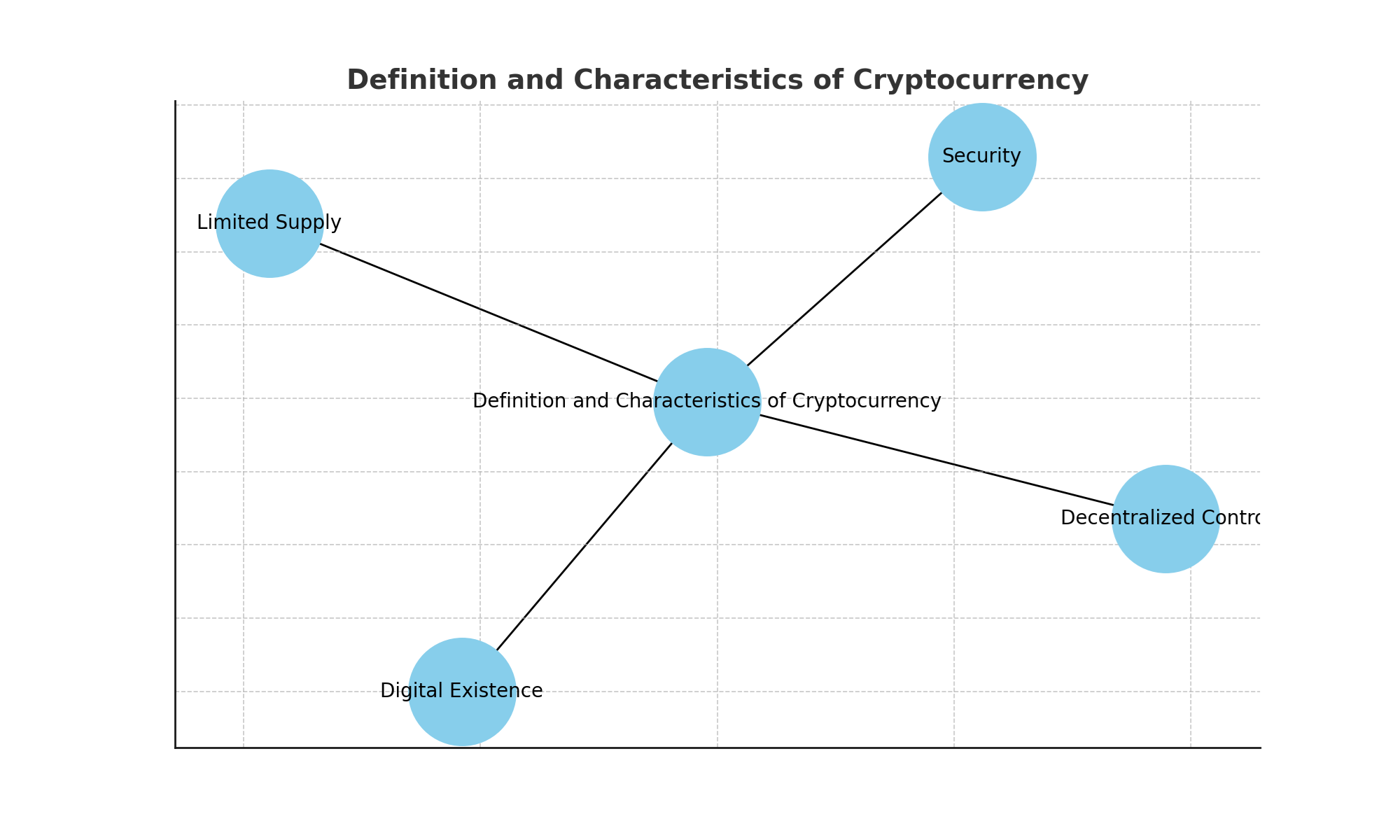
Key characteristics of cryptocurrency include:
- Decentralized Control: Cryptocurrencies are not governed by any central authority. Instead, they rely on a distributed network of computers (nodes) to validate and record transactions, ensuring transparency and security.
- Digital Existence: Cryptocurrencies exist only in digital form and do not have a physical counterpart. They are stored in digital wallets and can be transferred electronically.
- Limited Supply: The supply of most cryptocurrencies is limited. For example, Bitcoin has a maximum supply of 21 million coins. This scarcity can contribute to their value.
- Security: Cryptocurrencies use advanced cryptographic techniques to secure transactions and control the creation of new units. This makes them resistant to fraud and counterfeiting.
These characteristics make cryptocurrencies a unique and innovative form of digital currency, offering an alternative to traditional fiat money.
Examples of Cryptocurrencies
Examples of popular cryptocurrencies include:
- Bitcoin (BTC): The first and most well-known cryptocurrency, often referred to as digital gold.
- Ethereum (ETH): Known for its smart contract functionality, enabling decentralized applications (dApps).
- Litecoin (LTC): Created as a lighter version of Bitcoin, offering faster transaction times.
- Bitcoin Cash (BCH): A fork of Bitcoin designed to improve transaction speed and scalability.
- Ripple (XRP): Focused on facilitating real-time, cross-border payments for financial institutions.
These cryptocurrencies represent a diverse range of digital currencies, each with unique features and use cases within the digital economy.
Why Cryptocurrencies Are Superior To Fiat Currency
Yet the most significant benefit of the blockchain technology is that it allows you to be your own bank and that the supply is not inflationary. For instance, Bitcoin is the most popular cryptocurrency which has a limited supply of 21 million.
Currently, the circulating supply is around 18 million, which means 80 percent of all bitcoins are mined already. The remaining 20 percent will be mined and added to the circulating supply approximately by the year 2140.
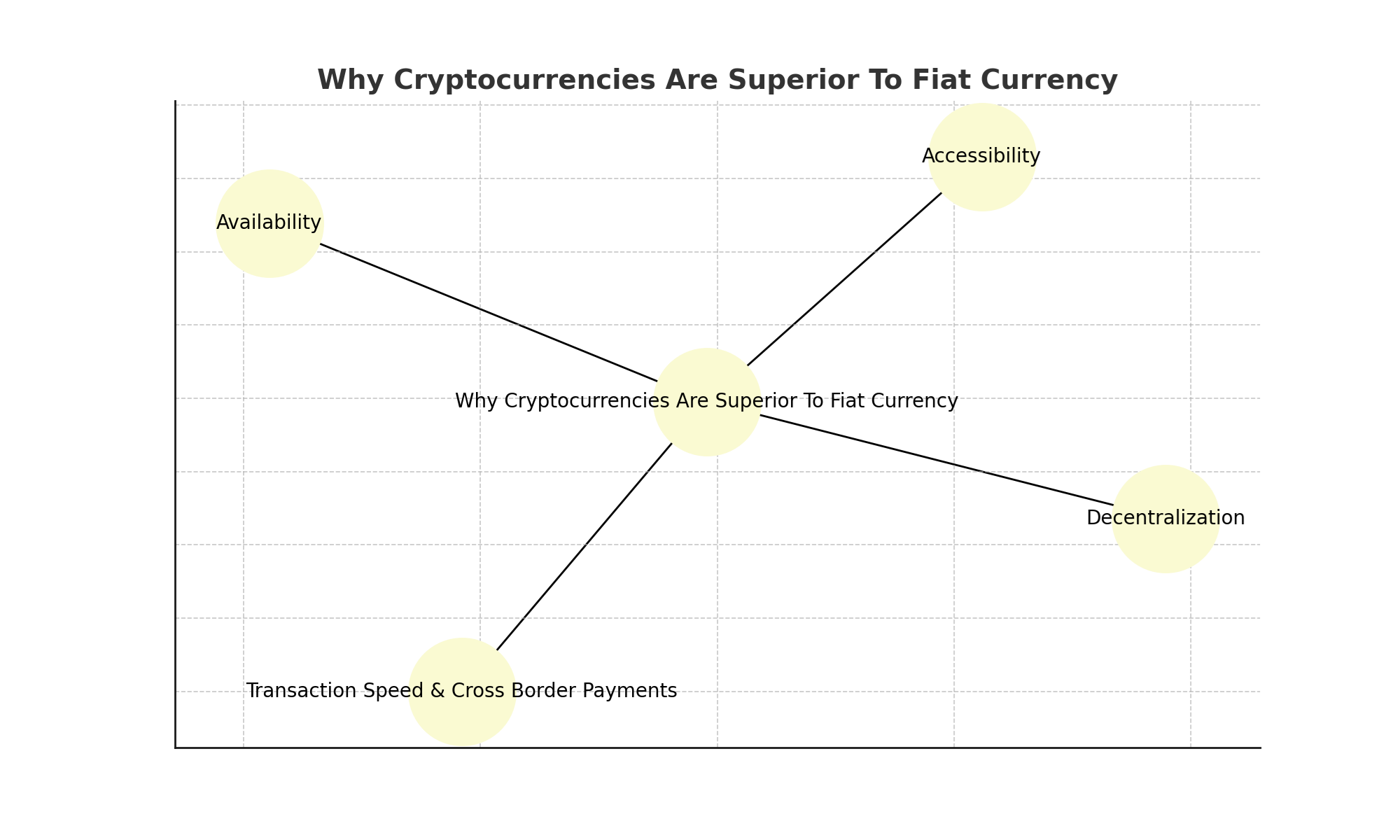
i. Decentralization
The mining process is like the money printing process of fiat currency – both need electricity and induce costs. However, the mining process of Bitcoin is decentralized, meaning everyone can participate in the mining process and you can’t shut it down by eliminating the central power because there is no central power. This, of course, is very different from the centralized money printing process which is done by the government, which is neither transparent nor can you participate in it.
ii. Transaction Speed And Cross Border Payments
Another huge advantage of cryptocurrencies versus fiat currencies is the transaction speed and availability of the money. For instance, cross border payments are very slow and inefficient, taking three to five working days until they arrive in the bank account.
In addition, the costs are very high, as it costs seven percent on average to send money internationally, while Bitcoin transactions need only minutes to hours and cost between $0.13 and $1.64, depending on if you want your Bitcoin to sent within ten minutes or one hour.
iii. Availability And Accessibility
What’s more, when it comes to availability, you can access your cryptocurrency wallet accounts from everywhere around the globe – all you need is an internet-ready device and an online connection. Imagine you want to get your money out of the bank, but the bank closed due to bankruptcy and won’t give you access to your money. Indeed, this happened numerous times throughout banking history, as there were dozens of banking crises in the last five decades.
The Bottom Line
Cryptocurrencies give the power back from the banks to the ordinary people and allow you to store, transfer and access your own funds by will at any time without the need for approval or surveillance of banks, which are manipulating the money supply with lack of transparency.
The lack of transparency ultimately ends up in a lack of control of its users, which are at the banks’ mercy. Cryptocurrencies are the better means of exchange and storage of money than fiat currency and don’t lack transparency and users’ control.
They enable you to be your own bank, having full control of your own money and access your money anytime from any place in the world. In addition, undertaking financial transactions without banks would tremendously increase the cost-efficiency and alter the global wealth distribution due to the elimination of all costs associated with banks and loans. Another key advantage is that while money is inflationary, cryptocurrencies are deflationary. Therefore cryptocurrencies should be part of everyone’s investment portfolio.
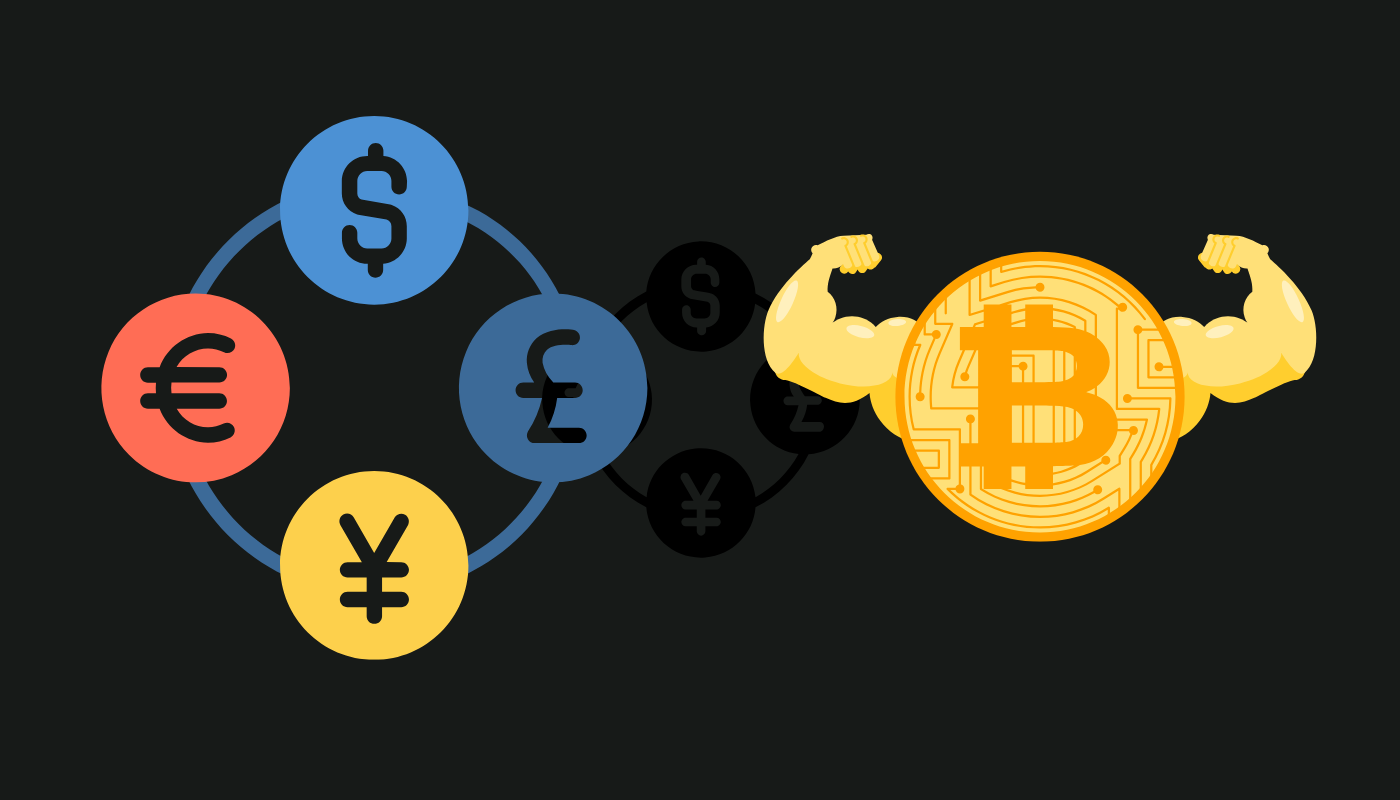
FAQs
1. What is fiat currency and how does it differ from cryptocurrency?
Fiat currency is government-issued money, such as the US Dollar, that derives its value from government backing and legal tender status. It is controlled by central banks and used in traditional financial systems.
Cryptocurrencies, on the other hand, are decentralized digital currencies that operate on blockchain technology without reliance on central authorities. While fiat currencies are widely accepted and regulated, cryptocurrencies offer greater transparency, limited supply, and faster transactions but are less universally recognized.
2. Can cryptocurrencies replace fiat currencies in the future?
Cryptocurrencies have the potential to replace fiat currencies in certain scenarios due to their efficiency, security, and global accessibility. However, challenges like regulatory uncertainty, market volatility, and limited adoption for everyday transactions currently hinder widespread replacement. Governments are also exploring Central Bank Digital Currencies (CBDCs) to modernize fiat systems while retaining control, indicating a possible coexistence rather than complete replacement.
3. What are the key risks of using cryptocurrencies?
The key risks of cryptocurrencies include:
- Market Volatility: Prices can fluctuate drastically within short periods.
- Regulatory Uncertainty: Lack of clear regulations in many countries may impact their legality and use.
- Security Concerns: Vulnerability to hacking and scams due to insufficient user safeguards.
- Limited Adoption: Cryptocurrencies are not universally accepted, making them impractical for certain transactions.
- Technical Complexity: New users may find understanding and managing digital wallets and blockchain systems challenging.
4. How do central banks control fiat currency value?
Central banks control fiat currency value through monetary policies, including:
- Adjusting Interest Rates: Raising or lowering rates influences borrowing, spending, and saving.
- Money Supply Management: Printing more money or restricting supply to stabilize inflation and deflation.
- Foreign Exchange Interventions: Managing currency value relative to other currencies to maintain economic stability.
These measures aim to balance economic growth, inflation, and employment.
5. Why is Bitcoin considered superior to fiat currencies?
Bitcoin is often considered superior to fiat currencies due to:
- Decentralization: It operates without central authorities, offering greater independence.
- Limited Supply: Bitcoin’s capped supply of 21 million ensures it is deflationary, unlike inflation-prone fiat currencies.
- Transparency: Blockchain technology makes all transactions publicly verifiable.
- Global Accessibility: Bitcoin can be sent and received anywhere with an internet connection, bypassing traditional financial institutions.
- Lower Transaction Fees: Particularly for cross-border payments, Bitcoin often costs less than traditional banking methods.
Despite these advantages, Bitcoin’s volatility and regulatory challenges are significant factors to consider.
